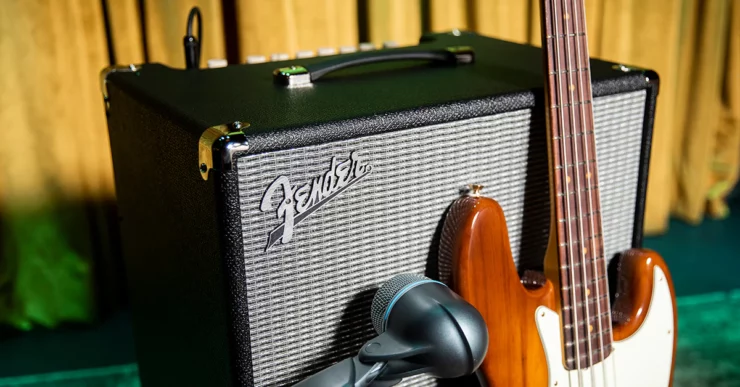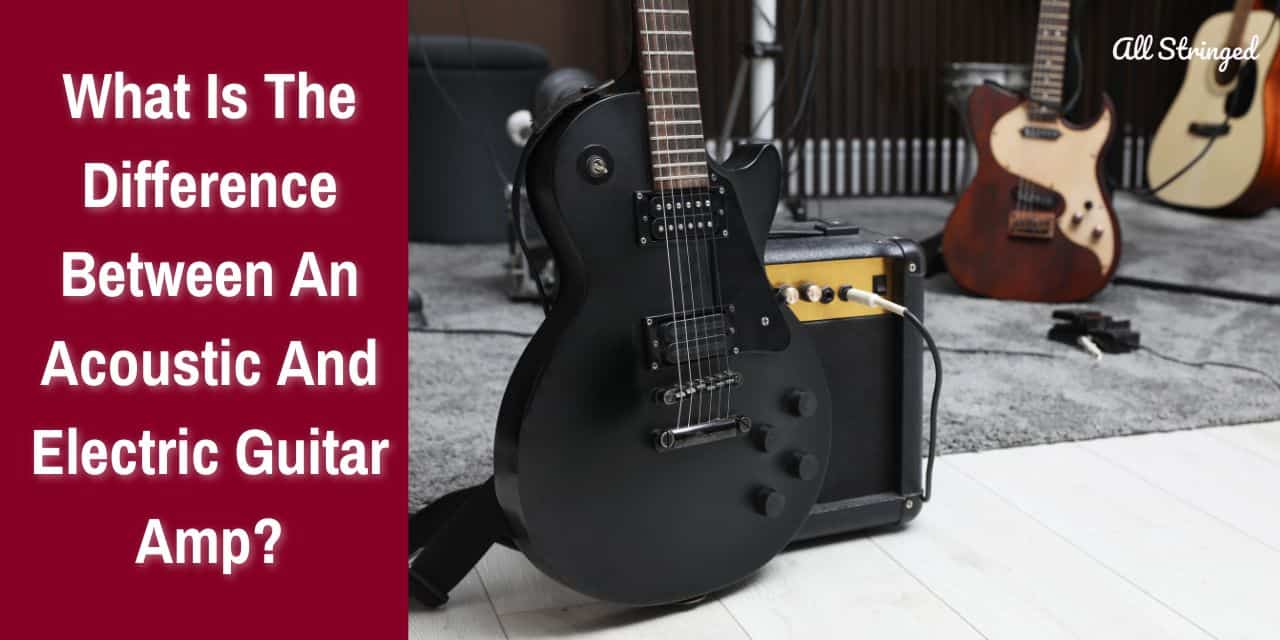As a guitarist, it is important to understand the difference between an acoustic and electric guitar amp. An acoustic guitar amp is designed to amplify the sound of an acoustic guitar and an electric guitar amp is designed to enhance the sound of an electric guitar. This article will provide an in-depth look at the differences between these two types of guitar amps and how they affect sound quality. By the end of this article, guitar players will have a better understanding of why they need both an acoustic and electric guitar amp to produce the best sound for their instrument.
What is an acoustic guitar amp?
Whether you are an aspiring guitarist or a professional musician, having the right equipment will be important to showcase the unique tones and nuances of your acoustic guitar. An acoustic amp is an important tool that allows you to amplify the natural sound of your instrument, enhancing its projection, and ensuring it is heard in different performance settings.
>>> Click here to read our review about the Top 15 Best Guitar Amps <<<
An acoustic amp is a specialized amp designed specifically for acoustic instruments like guitars, violins, and mandolins. Unlike electric guitar amps, which are tailored to the characteristics of electric guitars, acoustic guitar amps are designed for reproducing the authentic and natural sound of acoustic instruments.
Here are some of the key features of acoustic guitar amps –
#1. Clean and transparent sound
Acoustic guitar amps are engineered to faithfully reproduce the tonal characteristics of acoustic instruments, delivering a clean and transparent sound. They aim to capture the subtleties, warmth, and richness of the instrument’s natural tone without coloration or distortion.
#2. Preamp and EQ controls
Acoustic guitar amps feature preamp controls, allowing you to adjust the volume, tone, and gain of your instrument. These controls help shape your sound and adapt it to different performance environments. Moreover, these controls shape your sound and adapt it to different performance environments. Many amps come with built-in EQ controls, allowing precise adjustment of bass, treble, and midrange frequencies to achieve the desired tonal balance.

#3. Feedback suppression
One common challenge when amplifying acoustic instruments will be the potential for feedback, which occurs when the amplified sound from the speakers is picked up by the instrument’s body and creates a loop of sound. To combat that, some acoustic guitar amps employ feedback suppression technology or built-in feedback notch filters, reducing the risk of feedback during performances.
#4. Versatile input options
Acoustic guitar amps offer a wide variety of input options to accommodate different instruments and sources. They typically offer both standard ¼” instrument inputs and XLR inputs for connecting mics or additional instruments. Some guitar amps also include a dedicated input for a piezo pickup or a balanced line input for connecting to a mixer or recording interface.
#5. Portability and size options
Acoustic guitar amps come in different sizes and power ratings to suit different needs. Compact and portable models are perfect for traveling musicians or intimate performances while larger amps with higher wattage ratings are suited for larger venues or band settings. You must consider the intended use and the size of the venues you will be playing in when choosing an amp.
What is an electric guitar amp?
When it comes to playing an electric guitar, having the right amp will be important for achieving the desired tone, power, and versatility. Electric guitar amps are designed specifically to amplify the unique characteristics of electric guitars, allowing musicians to shape their sound and explore a wide range of tones.
An electric guitar is an electronic device designed for amplifying the sound produced by an electric guitar. Unlike acoustic guitar amps, electric guitar amps often include built-in effects, tone-shaping controls, and additional features to cater to the specific needs of electric guitar players. They play a key role in shaping the overall sound and character of an electric guitar.
Here are some of the key features of electric guitar amps –
#1. Amplification and power
Electric guitar amps are built for providing sufficient amplification to project the sound of an electric guitar in various performance settings. They come in a wide range of power ratings, typically measured in watts, allowing musicians to choose an amp suitable for bedroom practice, studio recording, or live performances in small to large venues.
#2. Speaker configuration
Electric guitar amps come in different speaker configurations like single-speaker or multi-speaker setups. The number and size of speakers impact the overall sound projection, tonal characteristics, and dispersion.
Smaller amps come with single speakers and they’re more suited for practice or small venues whereas larger amps with multiple speakers offer greater volume and fuller sounds for larger stages or band performances.

#3. Built-in effects and modeling
Many electric guitar amps include built-in effects and digital modeling capabilities. These features allow guitarists to experiment with different sounds, emulate iconic amp models, and add depth to their playing.
Common effects found in electric guitar amps include reverb, chorus, delay, overdrive, and distortion. Amp modeling technology replicates the sound characteristics of popular amp models, giving musicians the ability to access a variety of tones without needing multiple physical amps.
#4. Connectivity options
Electric guitar amps offer a range of connectivity options to accommodate various setups and preferences. These can include auxiliary inputs for connecting external audio devices like smartphones or music players, line outputs for recording or connecting to PA systems, headphone jacks for private practice, and effects loops for integrating external effects pedals.
#5. Portability and size
Electric guitar amps come in different sizes and portability options. Compact practice amps are lightweight and designed for home use or small rehearsals whereas larger combo amps or amp heads with separate speaker cabinets offer more power and versatility for gigging musicians. You must consider the size and portability requirements based on your playing needs and transportation capabilities.
What is the difference between an acoustic and electric guitar amp?
Amps play a key role in shaping and enhancing the sound of guitars. Whether you are an acoustic guitar player or an electric guitar enthusiast, choosing the right amp will help you achieve the desired tone and projection. Acoustic guitar amps and electric guitar amps are designed for catering to the specific needs of different types of guitars. While they share a few similarities, such as amplifying the sound of guitars, there are a few differences in their features and functionalities. Knowing what is the difference between an acoustic and electric guitar will help you choose the right amp for your guitar and musical needs.
#1. Purpose and design
The primary distinction between acoustic guitar amps and electric guitar amps lies in their purpose and design. Acoustic guitar amps are designed to faithfully reproduce the natural sound of acoustic instruments. They are designed to faithfully reproduce the natural sound of acoustic instruments. They are built for accentuating the acoustic guitar’s tonal qualities and provide clear, uncolored amplification.
In comparison, electric guitars are designed to shape and manipulate the electric guitar’s sound, offering an impressive range of tonal possibilities through various effects and preamp controls.
#2. Amplification requirements
Acoustic guitar amps are generally lower in power compared to electric guitar amps. Acoustic guitars produce sound through their hollow bodies whereas acoustic amps are designed to amplify this sound while also maintaining its natural resonance. Acoustic guitar amps typically have lower wattage ratings, ranging from 15 to 100 watts, suitable for smaller venues and personal practice.
Meanwhile, electric guitars require more amplification due to the nature of electric guitars. Electric guitars rely on electromagnetic pickups to capture the string vibrations, which are then amplified by the guitar amp. These amps come in a wide range of power ratings, from low-wattage practice amps to high-wattage stage amps. They are designed to produce powerful, distorted tones needed for genres like metal and rock.

#3. Power ratings
Power ratings refer to the electrical power output of an amp and it is measured in watts. Acoustic guitar amps typically have lower ratings compared to electric guitar amps. This is because acoustic guitars produce a naturally resonant sound that requires less amplification. Acoustic guitar amps typically range from 15 to 100 watts and they are suitable for smaller venues and personal practice.
Electric guitar amps, on the other hand, come in a wide range of power ratings, from low-wattage practice amps to high-wattage stage amps. Electric guitars require more amplification for achieving the desired tonal characteristics and volume, High-wattage electric amps are capable of producing powerful, distorted tones needed for genres like rock and metal whereas low-wattage amps are ideal for practice or smaller venues.
#4. Tone controls
Tone controls play a key role in shaping the sound of the guitar. Acoustic guitar amps often feature basic tone controls, such as bass, treble, and midrange knobs. These allow you to adjust the frequency response to achieve a balanced, natural tone. Some acoustic amps might also include additional controls like notch filters or feedback suppression to minimize feedback issues common with acoustic instruments.
In comparison, electric guitar amps offer more extensive tone-shaping capabilities. They typically feature EQ controls for bass, treble, and midrange, allowing precise control over the frequency spectrum. Electric guitar amps might also include additional tone-shaping options such as presence, resonance, or contour controls, giving you more flexibility to shape your desired guitar tone.
#5. Effects
Effects are an integral part of guitar playing, adding depth, texture, and character to the sound. Acoustic guitar amps generally have fewer built-in effects compared to electric guitar amps. They might offer basic effects like reverb or chorus, which are commonly used to enhance the acoustic guitar’s natural sound. However, acoustic guitar players often rely on external effects pedals or processors for achieving a wider range of effects.
Meanwhile, electric guitar amps are known for their extensive built-in effects. They might include effects like delay, reverb, modulation, (chorus, flanger, phaser), and overdrive/distortion. Some electric guitars also offer advanced digital modeling, allowing you to replicate the sounds of various iconic amps and effects. This versatility makes electric guitars the go-to option for musicians looking for a wide array of effects without the need for external pedals.
#6. Connectivity
Connectivity options play a key role in integrating your amp with other audio devices or equipment. Acoustic guitar amps typically have limited connectivity options. They usually have inputs for guitar and, in some cases, a mic input for vocals. Some acoustic amps might offer auxiliary inputs for connecting external audio devices or line outputs for direct recording.
Meanwhile, electric guitar amps offer more connectivity options to accommodate various setups. They often include multiple input channels for guitars, mics, or other instruments. Electric guitar amps might also feature headphone outputs for silent practice, line outputs for direct recording, and effects loops for integrating external effects pedals.
Pros and cons of acoustic guitar amps
Acoustic amps are specialized amps designed to accurately reproduce the natural and authentic sound of acoustic instruments. These amps play a key role in enhancing the volume and projection of acoustic guitars in various performance settings. However, like any piece of equipment, acoustic guitar amps come with their own set of pros and cons. Here are the different pros and cons that you should keep in mind when choosing the right amp for your acoustic guitar needs.
Here are the pros of acoustic guitar amps –
#1. Enhanced sound projection
Acoustic guitar amps are specifically designed to amplify the unique tonal characteristics of acoustic instruments, allowing you to be heard clearly in larger venues or band settings. They provide sufficient power and volume to ensure your guitar’s sound cuts through the mix and reaches your audience.
#2. Offers tone shaping controls
Acoustic guitar amps come with built-in equalization controls, which allow you to shape and fine-tune your guitar’s tone. With dedicated bass, treble, and midrange knobs, you’ll be able to adjust the frequency response to achieve the desired tonal balance and accommodate different playing styles or performance environments.
#3. Feedback control
A common challenge when amplifying acoustic instruments is the potential for feedback, which occurs when the amplified sound from the speakers is picked up by the instrument’s body and creates a loop of sound. Acoustic guitar amps often include feedback suppression or notch filter features to minimize feedback issues, allowing you to perform with confidence.
#4. Versatility
Acoustic guitar amps aren’t limited to amplifying guitars alone. Many models provide multiple channels, allowing you to connect additional instruments, mics, or external audio devices. This versatility makes them suitable for solo performances, small ensembles, or singer-songwriter setups where you have to amplify multiple sound sources simultaneously.
#5. Compact and lightweight
Acoustic guitar amps are available in a wide range of sizes, including compact and lightweight models that are easy to transport. These portable amps are perfect for traveling musicians, buskers, or guitarists who frequently perform in different locations. They offer the convenience of amplification without compromising on sound quality.
Here are the cons of acoustic guitar amps –
#1. Limited sound customization
While acoustic guitar amps offer tone-shaping controls, they might not offer the same level of sound customization as dedicated audio processors or pedal effects. If you prefer extensive sound manipulation or want to experiment with a wide range of effects, you might find the options limited with an acoustic guitar amp.
#2. Lack of sound coloration
Some acoustic guitar amps might add a subtle coloration to the sound, altering the natural tone of your instrument. This coloration can be a matter of personal preference but if you want a completely transparent amplification of your acoustic guitar’s sound, you might have to consider higher-end, transparent amps or dedicated acoustic preamps.
#3. Excessive costs
Compared to non-amplified acoustic guitars, investing in an acoustic guitar amp can add to the overall cost. While there are affordable options out there, higher-end models with advanced features and superior sound quality can be fairly expensive. You must consider your budget and requirements before making the purchase.
#4. Power limitations
Acoustic guitar amps are typically designed for small to medium-sized venues. If you frequently perform in larger venues or with loud bands, you might find that the power output of some acoustic guitar amps is insufficient. In such cases, you might have to consider higher-wattage models or explore other amplification options such as a PA system.
Pros and cons of electric guitar amps
Electric guitar maps play a major role in shaping the sound and delivering the distinct tones that electric guitarists desire. These amps are specifically designed for enhancing the characteristics of electric guitars, providing musicians with the power, versatility, and effects they have to create their unique sonic landscapes. Similar to acoustic guitar amps, electric guitar amps also have their set of pros and cons. Here are some of the main pros and cons of electric guitar amps to help you select the right amp for your electric guitar needs.
Here are the pros of electric guitar amps –
#1. Distinctive tone
Electric guitar amps are engineered to bring out the unique tonal characteristics of electric guitars. They shape the sound through different preamp controls, such as gain, volume, and tone knob, allowing musicians to achieve a wide range of tones, from clean and crisp to crunchy and distorted. The distinctiveness of electric guitar tone is an important factor that draws many musicians to these amps.
#2. Wide range of effects
Electric guitar amps often come equipped with built-in effects like delay, reverb, chorus, distortion, and overdrive. These effects allow guitarists to experiment with different sonic textures and add depth and complexity to their playing. Having these effects built into the amplifier eliminates the need for additional pedals or processors, making it convenient for live performances and rehearsals.
#3. Versatility
Electric guitar amps are capable of delivering immense versatility. They can be used for different music genres, from rock and blues to jazz and metal. Many electric amps offer multiple channels, allowing guitarists to switch between clean and distorted sounds or access different tonal presets, making them suitable for different playing styles and musical contexts.
#4. Power and volume
Electric guitar amps are designed to deliver ample power and volume, enabling musicians to play in different settings, from small venues to large stages. The power rating of an electric guitar amp is measured in watts. Higher-wattage amps are capable of providing greater headroom, allowing for cleaner tones at higher volumes or the option to drive the amp into natural overdrive for a gritty sound.
#5. Customizing the tone
Electric guitar amps offer extensive tone-shaping controls, including EQ knobs, allowing players to tailor their sound precisely to their preferences. Moreover, many electric guitar amps also offer options for adjusting presence, resonance, and other parameters, providing further customization opportunities for players to achieve their desired tones.
Here are the cons of electric guitar amps –
#1. Size and portability
Electric guitar amps can be bulky and heavy, especially when considering high-wattage or combo amps. This can make them less portable, especially for musicians and guitarists who have to travel frequently or perform in different locations. However, they are smaller and more portable options available for those looking for a more compact solution.
#2. Tricky sound projection
Electric guitar amps are designed primarily for close-miking or amplifying sound in small to medium-sized venues. In larger venues or outdoor settings, they might struggle to project sound adequately. In such cases, additional sound reinforcement systems, like PA systems, might be needed for achieving the desired volume and coverage.
#3. High cost
High-quality electric guitar amps, especially the ones with advanced features and superior sound quality, can be relatively expensive. While there are many budget-friendly options available, investing in a high-quality amp could require a significant financial commitment. Consider your budget and playing needs before making the purchase.
#4. Maintenance and repairs
Like any other electronic equipment, electric guitar amps might require occasional maintenance or repairs. Tubes, speakers, or other components might require replacement over time, and repairs can be quite costly depending on the extent of the issue. Regular maintenance and careful handling will help prolong the lifespan of an amp and reduce the likelihood of repairs.
FAQs
What is the main difference between an acoustic and electric guitar amp?
The main difference between an acoustic and electric guitar amp is the type of signal they process. Acoustic amps are designed to amplify the signal from acoustic guitars (which produce an acoustic sound) while electric guitar amps are designed to amplify the signal from electric guitars (which produce an electric sound).
What are the benefits of using an acoustic amp?
Using an acoustic amp can provide a number of benefits, including a more natural tone and greater control over the sound. Acoustic amps are also designed to work with acoustic pickups, allowing for a greater range of tones and volume levels.
What are the benefits of using an electric guitar amp?
Using an electric guitar amp can provide a number of benefits, including a greater range of tones, more power, better projection, and improved sustain. Electric guitar amps are also designed to work with electric pickups, providing a greater range of tones and volume levels.



